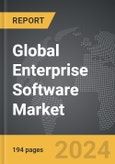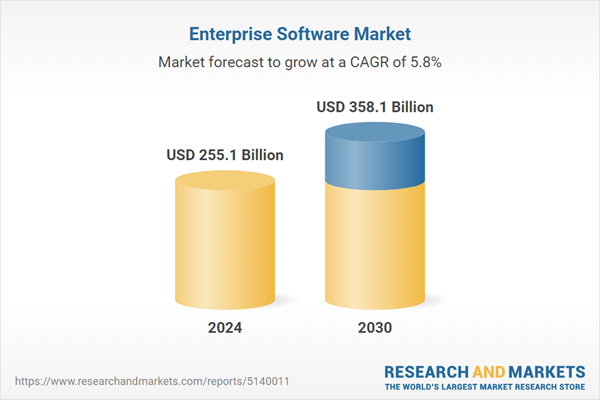The global market for Enterprise Software was valued at US$255.1 Billion in 2024 and is projected to reach US$358.1 Billion by 2030, growing at a CAGR of 5.8% from 2024 to 2030. This comprehensive report provides an in-depth analysis of market trends, drivers, and forecasts, helping you make informed business decisions. The report includes the most recent global tariff developments and how they impact the Enterprise Software market.
Segments: Type (Customer Relationship Management (CRM), Enterprise Resource Planning (ERP), Business Intelligence (BI), Content Management, Supply Chain Management (SCM), Other Types).
Geographic Regions/Countries: World; United States; Canada; Japan; China; Europe (France; Germany; Italy; United Kingdom; Spain; Russia; and Rest of Europe); Asia-Pacific (Australia; India; South Korea; and Rest of Asia-Pacific); Latin America (Argentina; Brazil; Mexico; and Rest of Latin America); Middle East (Iran; Israel; Saudi Arabia; United Arab Emirates; and Rest of Middle East); and Africa.
The analysts continuously track trade developments worldwide, drawing insights from leading global economists and over 200 industry and policy institutions, including think tanks, trade organizations, and national economic advisory bodies. This intelligence is integrated into forecasting models to provide timely, data-driven analysis of emerging risks and opportunities.
Global Enterprise Software Market - Key Trends & Drivers Summarized
What Is Driving the Surge in Enterprise Software Demand?
The enterprise software market has experienced significant transformation over the past decade, driven primarily by the rapid evolution of digital technology. This sector encompasses a wide range of applications designed to address complex business needs, including resource planning, customer relationship management, business intelligence, and supply chain management systems. As businesses worldwide strive for increased efficiency, scalability, and competitive differentiation, the adoption of these systems has seen a marked increase. The rise of cloud computing has particularly been a game-changer, offering businesses of all sizes access to sophisticated capabilities without the need for substantial upfront investment in IT infrastructure. Moreover, the integration of AI and machine learning has enabled more predictive capabilities in enterprise software, enhancing decision-making processes and operational efficiencies across various industries.How Are Changing Work Dynamics Shaping Enterprise Software Solutions?
In the wake of globalization and the shift towards remote working models, particularly accelerated by the COVID-19 pandemic, there has been a pronounced shift in work dynamics. This transition has necessitated the development of more robust and flexible enterprise software that can support decentralized work environments. Today’s enterprise solutions are increasingly mobile-friendly, supporting a range of devices and operating systems, which facilitates seamless communication and collaboration across geographically dispersed teams. Furthermore, there is a growing emphasis on real-time data access and collaboration tools integrated within enterprise systems, which are crucial for maintaining operational continuity and real-time decision-making in a distributed workforce environment.What Role Does Customization Play in Enterprise Software Adoption?
Customization has become a critical factor in the adoption of enterprise software. Businesses demand solutions that can be tailored to their specific operational needs and integrated seamlessly with existing workflows. Vendors are responding by offering more modular software architectures, allowing for the addition of specific functionalities without disrupting the core system. This flexibility not only enhances the user experience but also ensures that software can evolve in tandem with business growth and changing market conditions. Additionally, as industries face varying regulatory environments, the ability to customize security features and compliance reporting is increasingly vital, adding another layer of complexity to the design and deployment of enterprise solutions.What Are the Primary Growth Drivers for the Enterprise Software Market?
The growth in the enterprise software market is driven by several factors that reflect technological advancements, strategic business needs, and shifting consumer behaviors. The proliferation of data and the subsequent need for robust data analytics capabilities are key drivers, as businesses require sophisticated tools to process and derive insights from vast amounts of information. The ongoing digital transformation initiatives across sectors also propel the demand for integrated enterprise systems that can streamline operations and enhance productivity. Furthermore, the increasing focus on customer experience has led companies to invest in CRM and related software that can provide a more personalized service. Regulatory compliance and the need for cyber security measures in an increasingly digital business environment continue to drive investments in enterprise software, ensuring that companies can keep pace with legal requirements and protect sensitive information effectively. These drivers highlight the interconnected nature of technological evolution and strategic business imperatives, underscoring the complex and dynamic landscape of the enterprise software market.Report Scope
The report analyzes the Enterprise Software market, presented in terms of units. The analysis covers the key segments and geographic regions outlined below.Segments: Type (Customer Relationship Management (CRM), Enterprise Resource Planning (ERP), Business Intelligence (BI), Content Management, Supply Chain Management (SCM), Other Types).
Geographic Regions/Countries: World; United States; Canada; Japan; China; Europe (France; Germany; Italy; United Kingdom; Spain; Russia; and Rest of Europe); Asia-Pacific (Australia; India; South Korea; and Rest of Asia-Pacific); Latin America (Argentina; Brazil; Mexico; and Rest of Latin America); Middle East (Iran; Israel; Saudi Arabia; United Arab Emirates; and Rest of Middle East); and Africa.
Key Insights:
- Market Growth: Understand the significant growth trajectory of the Customer Relationship Management (CRM) segment, which is expected to reach US$128.8 Billion by 2030 with a CAGR of a 7.0%. The Enterprise Resource Planning (ERP) segment is also set to grow at 5.5% CAGR over the analysis period.
- Regional Analysis: Gain insights into the U.S. market, valued at $66.6 Billion in 2024, and China, forecasted to grow at an impressive 10.0% CAGR to reach $86.2 Billion by 2030. Discover growth trends in other key regions, including Japan, Canada, Germany, and the Asia-Pacific.
Why You Should Buy This Report:
- Detailed Market Analysis: Access a thorough analysis of the Global Enterprise Software Market, covering all major geographic regions and market segments.
- Competitive Insights: Get an overview of the competitive landscape, including the market presence of major players across different geographies.
- Future Trends and Drivers: Understand the key trends and drivers shaping the future of the Global Enterprise Software Market.
- Actionable Insights: Benefit from actionable insights that can help you identify new revenue opportunities and make strategic business decisions.
Key Questions Answered:
- How is the Global Enterprise Software Market expected to evolve by 2030?
- What are the main drivers and restraints affecting the market?
- Which market segments will grow the most over the forecast period?
- How will market shares for different regions and segments change by 2030?
- Who are the leading players in the market, and what are their prospects?
Report Features:
- Comprehensive Market Data: Independent analysis of annual sales and market forecasts in US$ Million from 2024 to 2030.
- In-Depth Regional Analysis: Detailed insights into key markets, including the U.S., China, Japan, Canada, Europe, Asia-Pacific, Latin America, Middle East, and Africa.
- Company Profiles: Coverage of players such as CA Technologies, Inc., Dell EMC, Hewlett Packard Enterprise Development LP (HPE), Mentor Graphics Corporation, Red Hat, Inc. and more.
- Complimentary Updates: Receive free report updates for one year to keep you informed of the latest market developments.
Some of the 42 companies featured in this Enterprise Software market report include:
- CA Technologies, Inc.
- Dell EMC
- Hewlett Packard Enterprise Development LP (HPE)
- Mentor Graphics Corporation
- Red Hat, Inc.
- Salesforce.com, Inc.
- Symantec Corporation
- Vmware, Inc.
Tariff Impact Analysis: Key Insights for 2025
Global tariff negotiations across 180+ countries are reshaping supply chains, costs, and competitiveness. This report reflects the latest developments as of April 2025 and incorporates forward-looking insights into the market outlook.The analysts continuously track trade developments worldwide, drawing insights from leading global economists and over 200 industry and policy institutions, including think tanks, trade organizations, and national economic advisory bodies. This intelligence is integrated into forecasting models to provide timely, data-driven analysis of emerging risks and opportunities.
What’s Included in This Edition:
- Tariff-adjusted market forecasts by region and segment
- Analysis of cost and supply chain implications by sourcing and trade exposure
- Strategic insights into geographic shifts
Buyers receive a free July 2025 update with:
- Finalized tariff impacts and new trade agreement effects
- Updated projections reflecting global sourcing and cost shifts
- Expanded country-specific coverage across the industry
Table of Contents
I. METHODOLOGYII. EXECUTIVE SUMMARY2. FOCUS ON SELECT PLAYERSIII. MARKET ANALYSISSOUTH KOREAREST OF ASIA-PACIFICARGENTINABRAZILMEXICOREST OF LATIN AMERICAIRANISRAELSAUDI ARABIAUNITED ARAB EMIRATESREST OF MIDDLE EASTIV. COMPETITION
1. MARKET OVERVIEW
3. MARKET TRENDS & DRIVERS
4. GLOBAL MARKET PERSPECTIVE
UNITED STATES
CANADA
JAPAN
CHINA
EUROPE
FRANCE
GERMANY
ITALY
UNITED KINGDOM
SPAIN
RUSSIA
REST OF EUROPE
ASIA-PACIFIC
AUSTRALIA
INDIA
LATIN AMERICA
MIDDLE EAST
AFRICA
Companies Mentioned (Partial List)
A selection of companies mentioned in this report includes, but is not limited to:
- CA Technologies, Inc.
- Dell EMC
- Hewlett Packard Enterprise Development LP (HPE)
- Mentor Graphics Corporation
- Red Hat, Inc.
- Salesforce.com, Inc.
- Symantec Corporation
- Vmware, Inc.
Table Information
| Report Attribute | Details |
|---|---|
| No. of Pages | 194 |
| Published | April 2025 |
| Forecast Period | 2024 - 2030 |
| Estimated Market Value ( USD | $ 255.1 Billion |
| Forecasted Market Value ( USD | $ 358.1 Billion |
| Compound Annual Growth Rate | 5.8% |
| Regions Covered | Global |









